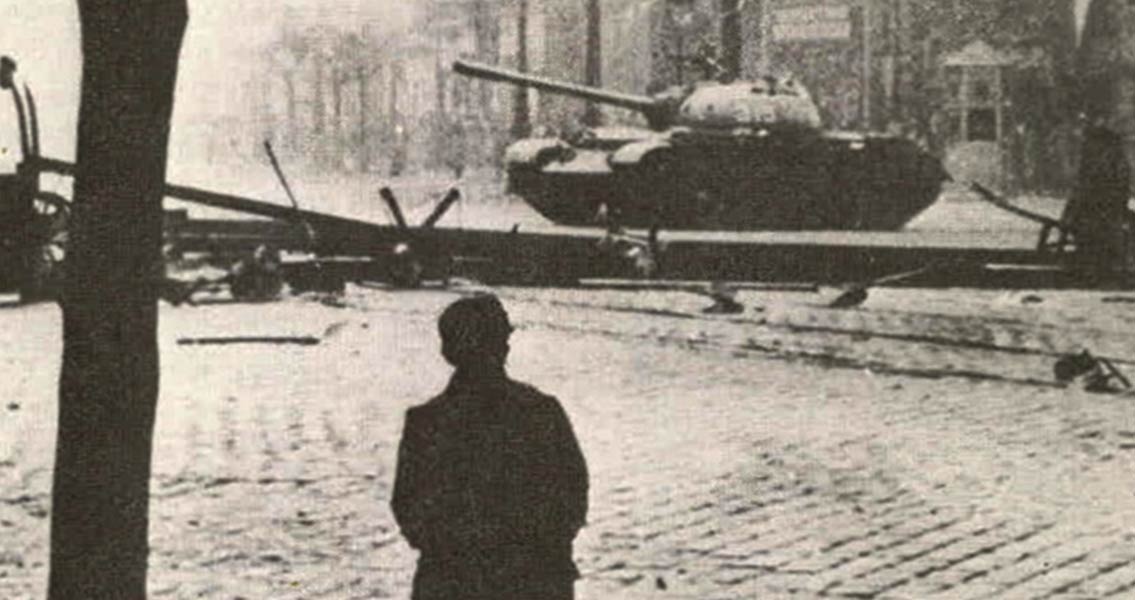<![CDATA[The 23rd October is Hungarian National Day, for the people of Hungary it is a date that symbolises the beginning of a long and painful fight for freedom that started in 1956. The date is significant for signposting two related events in the country's history. An attempt at democratic revolution in 1956 that was aggressively suppressed by the Red Army, and, on the same date 33 years later, the establishment of the Republic of Hungary, the crucial first step towards parliamentary democracy. Hungary was liberated by the Soviet Union at the end of the Second World War in 1945. Like many nations in Eastern Europe, the end of German occupation didn't symbolise a new era of freedom, but the start of decades of domination by the USSR. The Communist Party, led by Stalin's "best pupil" Mátyás Rákosi, was quickly installed in power in Budapest. Rákosi consolidated power in brutal fashion, and by 1949 had styled Hungary as the People's Republic of Hungary. All opposition political parties had been banned, and over 300,000 Hungarians were exiled, killed or imprisoned. Rákosi was supported in the Kremlin, but deeply unpopular in his home country After Stalin's death in 1953, he was replaced by Imre Nagy, a softer leader with much greater appeal in Hungary. Nagy started a process of rolling back Soviet control; releasing political prisoners and improving the quality of life for the people of Hungary. Growing popular support ultimately proved to be his undoing, in April 1955 Rákosi was returned to power. Rákosi was then replaced by the hard line Stalinist Erno Gero in 1956. Under Gero the AVO (secret police in Hungary) became much more aggressive, and popular discontent started to grow. Nikita Kruschev's policy of de-stalinisation had upset the balance of power in Eastern Europe. Countries started to sense an opportunity to win back self-control. Earlier in 1956 an uprising in Poland had triggered heavy Soviet repression, but also some democratic concessions from the Politburo. The event proved inspiring to the people of Hungary, suggesting that in a post-Stalin Europe, the Soviet Union might be more receptive to popular protest. There was a host of reasons for the protests that started in 1956. The secret police had installed a state of censorship, fear and paranoia throughout the country, Moscow dictated what was taught in Hungarian schools and Communism had severely restrained the Hungarian economy. Soviet domination had also severely constrained the country's national identity. Although a deeply religious country, the Communist party had banned religious worship and imprisoned one of the most popular Cardinals, Mindszenty. The demonstrations started with a peaceful student and worker protest in the capital Budapest. The Kremlin took a surprisingly diplomatic approach to the protests. Nagy was reappointed prime minister, and Janos Kadar foreign minister. It was hoped that these two liberal politicians would appease the protestors. In further concessions, the Red Army withdrew from Moscow, Mindszenty was freed from prison, and rival political parties were allowed to start up. Unfortunately, just a few days later Hungary would learn just how much freedom the Soviet Union was willing to concede, and how much support was on offer from the West. On 31st October Nagy publicly announced that he intended to withdraw Hungary from the Warsaw Pact. Kadar realised that this was too far. He quickly quit the government and set up a rival administration, backed by Soviet tanks, in the east of Hungary. On 4th November the Red Army marched into Budapest to restore order. Details of what happened over the next few days are distorted by time, censorship and hyperbole, but it seems the Soviet soldiers acted with horrifying brutality. It is estimated that up to 30,000 people were killed, among them Nagy, who was executed and buried in an unmarked grave. By November 14th order was restored, Kadar had been put in charge of the government and Hungary was once again an undoubtedly Soviet country. The suppression in Hungary also sent out an ominous message to the rest of Eastern Europe. Despite public calls for help from Nagy, the United States and other Western countries failed to intervene in Budapest. The reasons for this are complicated. The USA, Britain and France were distracted by the Suez Crisis, something they considered of far more immediate importance. American politicians made public declarations of support for Hungary, but nothing more. It seems likely that these countries had calculated that intervention would have led to a full scale nuclear war with the Soviet Union, a risk no leader was willing to take. A message had been sent throughout the Soviet Union, firstly, the USSR would be just as heavy handed as it had been under Stalin and secondly, the Eastern Bloc countries could not depend on help from the other side of the Iron Curtain. It would take exactly 33 years for Hungarians to get the freedom they had asked for in 1956. On 23rd October 1989, the body of Imre Nagy was reburied in a service watched by 100,000 Hungarians. It was clear that the Soviet Union was coming to an end, and by 24th March 1990, Hungary held its first free elections since 1945.]]>
Hungarian National Day – a Long Way to a Happy Ending
